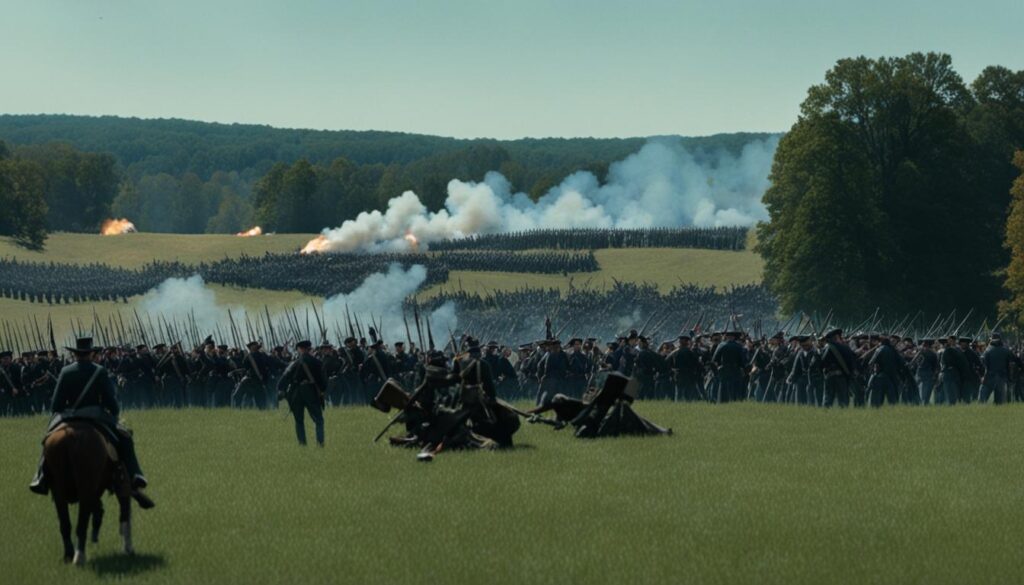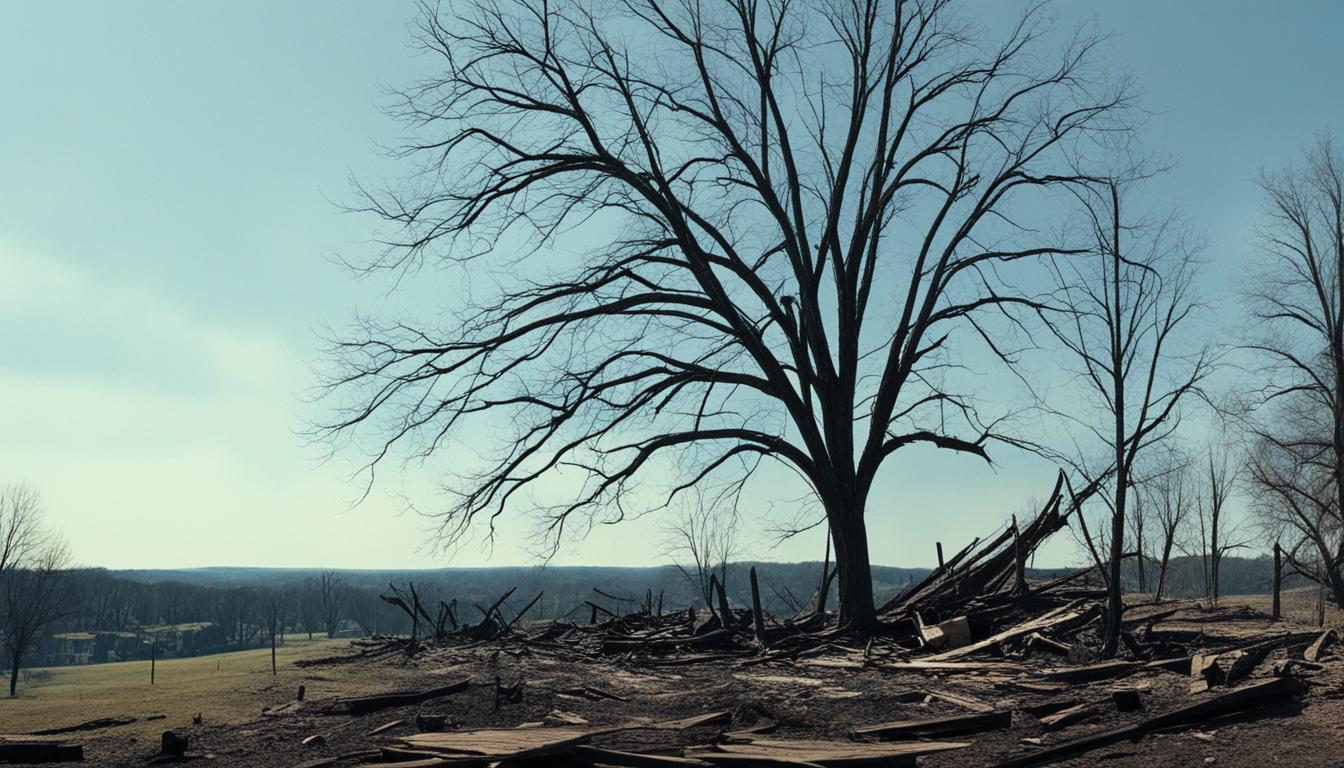The American Civil War, often regarded by historians as a “total war,” was not confined to distant battlefields. It reached into the lives of civilians, particularly in the South, as farms and towns became part of the conflict. Remarkably, the war both began and concluded on the same historic site – the property that encompassed the Manassas battlefield in Virginia, where the First Battle of Manassas erupted in July 1861, and the Appomattox Court House, where General Robert E. Lee ultimately surrendered to General Ulysses S. Grant in April 1865.
These Civil War battlefields serve as tangible reminders of the immense sacrifices made during this pivotal period in American history. Manassas, the site of two major battles, and Appomattox Court House, where the war effectively ended, have become iconic historic sites that continue to be visited and studied to this day.
Key Takeaways
- The Civil War was fought not only on battlefields but also on civilian farms and in towns, especially in the South
- The war began and ended on the same property – Manassas battlefield and Appomattox Court House
- The First Battle of Manassas took place in July 1861
- General Robert E. Lee surrendered to General Ulysses S. Grant at Appomattox Court House in April 1865
- These historic sites serve as reminders of the sacrifices made during the Civil War
The Significance of Manassas Battlefield
The First Battle of Manassas, also known as the Battle of Bull Run, was a pivotal moment in American history that took place on July 21, 1861. The battle occurred on the fields of Manassas, Virginia, marking the first major land battle of the American Civil War. The clash between Union and Confederate forces at Manassas set the stage for the long and bloody conflict that would follow.

One of the most poignant stories to emerge from the Battle of Bull Run is that of Judith Henry, an elderly civilian who found herself caught in the crossfire. Henry’s home, located between the opposing lines, was used by Confederate sharpshooters as a strategic position. Unaware that Henry was still inside, Union Major General James Ricketts ordered the house to be shelled by Federal artillery. Tragically, a shell burst through the ceiling of Henry’s room, causing her severe wounds that led to her death later that day.
The story of Judith Henry serves as a stark reminder of the civilian casualties and the immediate impact of the Civil War on the lives of ordinary people. The Battle of Manassas not only resulted in military losses but also brought destruction and hardship to the civilian population caught in the middle of the conflict.
The First Battle of Manassas, with its significant casualties on both sides, shattered the illusion that the Civil War would be a short and easily won conflict. The battle demonstrated the bravery and determination of both Union and Confederate soldiers, setting the tone for the long and grueling war that would consume the nation for the next four years.
Destruction and Hardship for Civilians During the War
The Civil War brought immense suffering and hardship to civilians in the Confederate states, particularly in the form of food shortages, property damage, and the creation of countless refugees. As the war progressed, the combination of drought, a diminished workforce on farms and plantations, and the Union Army’s increasing control over Confederate territory led to severe scarcity of food and essential supplies.
The mounting food shortages were exacerbated by rampant hyperinflation, causing prices to soar to unprecedented levels. This dire situation culminated in events such as the Richmond Bread Riots of April 1863, where desperate civilians, mostly women, took to the streets to protest the unaffordable cost of bread and other necessities. Many families were forced to seek out substitutes for basic items or simply go without, leading to widespread hunger and malnutrition.
As the conflict raged on, countless civilians found themselves displaced, becoming refugees in their own country. The decision to flee their homes was not an easy one, as they faced numerous challenges, including limited transportation options and the heart-wrenching choice of which possessions to take with them. The majority of those who managed to escape were affluent families with the means and connections to travel, while the general population often had fewer options due to the pervasive shortages and scarce resources.
The widespread property damage inflicted by both Union and Confederate armies further compounded the misery of civilians. Homes, farms, and businesses were destroyed or confiscated, leaving many with nothing to return to even after the war ended. The psychological toll of these losses, combined with the trauma of witnessing the horrors of war firsthand, left an indelible mark on the civilian population of the Confederate states.
The Lasting Impact of the Civil War on the South
The Civil War had profound and long-lasting effects on the American South, both economically and socially. In the aftermath of the war, the South faced immense challenges during the Reconstruction era. The region’s economy, which had been heavily reliant on slave labor and agriculture, was in shambles. Many former slaves found themselves without land or resources, forced to work as laborers on large white-owned farms and plantations.
The emergence of the sharecropping system became a defining feature of the post-war South. Under this arrangement, poor farm laborers, many of them African Americans, rented small plots of land from landowners and paid a portion of their crop as rent. While sharecropping provided some degree of autonomy, it often led to cycles of debt and exploitation, as farmers struggled to make ends meet in the face of high costs and low crop prices. The South’s continued reliance on cotton and the plummeting prices for the crop further exacerbated the economic challenges facing the region.
In addition to economic upheaval, the Civil War brought about significant social changes in the South. The passage of the 14th and 15th Amendments granted citizenship rights and the right to vote to African Americans, marking a crucial step towards racial equality. However, these rights would continue to be denied and suppressed throughout the Jim Crow era, as various legal and economic devices were employed to maintain racial segregation and inequality. The legacy of the Civil War and the struggle for civil rights would continue to shape the social and political landscape of the South for generations to come.

Leave a Reply